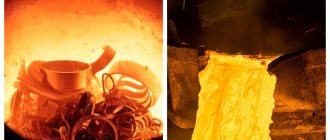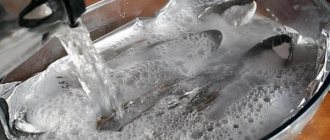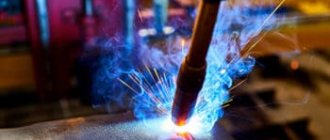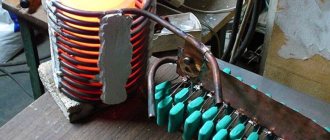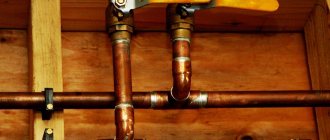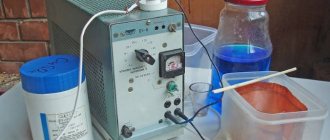Bronze products are widely used among amateur craftsmen who make various objects of art, weapons and accessories, jewelry, etc.
The lack of a production base is not an obstacle to the work; the main problem is the lack of information about the properties, melting point of bronze and processing modes of copper alloys. Most amateurs do not know that bronze casting is also done at home; the main thing is to follow the technology and provide the necessary conditions for the process to proceed.
Classification
Bronze alloys according to their composition are divided into:
- Tin.
- Tinless.
As the name implies, this refers to the presence or absence of tin in them. The latter are aluminum, silicon, beryllium and others, depending on the main alloying component.
Additives affect the quality of the alloy in different ways:
- Tin – adds strength and improves anti-friction properties. Large amounts of tin make metal brittle.
- Beryllium strengthens the material well; its properties are comparable to steel.
- Lead – improves corrosion resistance.
- Aluminum – again corrosion resistance and anti-friction qualities.
- Iron – improves structure and strength properties.
According to their technological properties, bronzes are divided into:
- Processable by pressure (deformable) - well stamped and forged.
- Foundry.
Brass grades and applications
The brand of brass and its scope of application depend on the composition. For example, tombak, which belongs to the class of wrought brasses, which contains more than 95% copper, can easily combine with steel, forming a bimetal with it. This compound is used in the manufacture of insignia and various objects of art and interior design - figurines, frames, candlesticks .
LO grade brass is used for the manufacture of condenser tubes used in various heating equipment, for example, gas boilers, autoclaves, and bellows.
The LS brand is used to create parts for watch mechanisms, adapters and connecting bushings. Printing matrices are also made from it.
LMC - is found in old Soviet coins with denominations up to 5 kopecks, fittings, nuts and bolts, and its subtype with the prefix “A” is found in parts of river and sea vessels.
Brass, marked LA or LZhM (and its subtypes), is also used for the construction of sea ships and aircraft, various electrical machines and bearings. Very common in parts for various chemical equipment.
This is interesting: How and what to clean copper oxide from at home: the most effective methods
Marking
The marking principle is as follows:
- They write the letters Br (meaning “bronze”).
- Write letters denoting alloying elements:
- Write numbers indicating the percentage of each element. For wrought bronzes, the numbers are written at the end of the markings in the same order as the letters. For foundries, a number is written after each alloying component. For example:
BrOF10-1 – deformable bronze. Tin is approximately 10%, phosphorus is 1%, the rest is copper. Or:
BrA10Zh3 – cast bronze, where aluminum is 10%, iron is 3%, the rest is copper.
There may be other impurities, but their number is insignificant.
A little history
Bronze is actually the first alloy that humanity began to use. In the 3rd millennium BC. e. craftsmen actively used copper for a variety of purposes. Some types of ore contained a small percentage of tin. When processing this material, people noticed that such copper is denser and harder than ordinary copper. Thus, this became the birth of a new historical and cultural period, which is now known as the “Bronze Age”. Further research led to the discovery of tin, which began to be specially added to copper to obtain a high-quality alloy for making tools and jewelry.
Bronze metallurgy qualitatively increased the productivity of a wide variety of industries in which humanity was occupied at that time. Melting gradually improved, and people began to make special stone molds in which various products could be cast repeatedly. Gradually, closed molds were invented, which made it possible to make weapons and jewelry with complex designs and patterns.
Read also: Types of cast iron, their use and labeling
Is it possible to cast bronze at home?
The good news is that this metal can be melted not only in industrial conditions, but also at home. True, “home” is a relative concept. You won't be able to pour in your kitchen. You need at least a separate room with good ventilation. This is for small things, such as small art castings. For large parts you will need a garage or hangar.
Bronze has low shrinkage - less than 1%, and is used to make precision castings. But in any case, it will not be possible to achieve industrial quality casting. And most importantly, you need to follow safety precautions and fire safety! They will be discussed at the end of the article.
Bronze scrap is used as a raw material; you can melt down plumbing parts with your own hands. The industry produces metal in ingots.
Melting point of bronze and how to melt and cast at home
Bronze is a copper-based alloy that does not contain nickel and zinc as the main alloying components. Characterized by a relatively high melting point, the metal becomes liquid in the range from +940°C to +1300°C. The most refractory is tin-phosphorus.
Bronze alloys are used to produce long products, sheets and pipes, engine parts, elements of transmission devices, liners for shut-off valves, fittings, taps, souvenirs, instrument parts and much more. You can make casting at home. Bronze is smelted in muffle furnaces or furnaces.
At the melting temperature, bronze becomes thick and does not flow well into the mold; you need to know some tricks in order to do casting yourself.
How to make a casting mold
The material for the mold (equipment) in non-industrial conditions is sand or clay mixture (casting into the ground) and gypsum.
Examples of mixtures for casting into the ground:
- sand, clay, coal dust in a ratio of 75% - 20% - 5%.
- clay, fireclay brick, thin sawdust, ratio 40% - 40% - 20%.
The components are mixed until a homogeneous consistency is obtained.
A model of a product made of wood or other material can also be used. It can also be a finished part, a sample.
A device for preparing sand equipment - a flask. It consists of two boxes without a lid, usually wooden. The lower one has a bottom, the upper one has no bottom (essentially a frame). The parts of the flask have centering elements for their precise location relative to each other. They are sometimes fastened together with clamps.
The equipment is made as follows:
- Before work, the surface of the flask and the product sample are sprinkled with talc.
- The sand mixture is poured into the bottom box to the edge and compacted.
- The model parts are placed in a flask on the ground and pressed.
- The upper frame is placed on the lower box of the flask.
- A truncated cone is attached to the model with its narrow part to the product. This is a model of the sprue; the melt will be poured through it. It is desirable that the sprue location be the thickest part of the product. It must be taken into account that the finished part may have defects at the pouring site.
- The upper flask is filled to the top with the mixture. They're ramming again.
- A model of the sprue is taken out of the sand.
- Use a sharp thin object to separate the upper and lower halves, marking the parting line. The upper flask with the sand mass in it is removed, and the product is carefully removed from the sand.
- The mold parts are dried and put back together.
The parting line is chosen so that the part can be removed from the tooling without damaging it. In addition, sometimes an “air vent” is made in the part of the product opposite the sprue. This is the same hole in the tooling as the sprue. Air escapes from the cavity through it during the filling process.
Foundry models
Artistic casting of bronze and brass involves obtaining the smoothest possible surface, so fairly hard materials are used to recreate the model:
- wood;
- gypsum;
- Ivory.
To obtain the smoothest possible surface, it is subjected to elimination of porosity by puttying, priming and varnishing. Casting models are made split; one-piece - suitable for casting products of simple shapes; special for parts with a rather complex configuration.
Pouring metal
In order to melt the material you will need:
- Melting muffle furnace, preferably with a heating regulator. For large castings you need a forge. Sometimes the material is melted with an autogen, a blowtorch, a gas or gasoline burner.
- Crucible - a steel, cast iron or fireclay (fireclay) container for melting, preferably with a spout.
- Tongs and a hook for removing the hot crucible from the furnace and other manipulations.
- Casting shape. How to prepare it for work is described below.
- Flux. Needed to protect the alloy from oxidation by air. Charcoal, borax.
- Fuel for the forge, for example, is the same charcoal.
- Ceramic or birch stick for stirring the melt.
SAFETY INSTRUCTIONS WHEN MELTING BRASS
During the process of smelting brass at home , or in industrial enterprises, precautions must be taken.
- The molds are removed using tongs with long handles.
- Work clothes should be made of non-flammable or flame-retardant fabrics and cover the maximum area.
- The face must be protected with a one-piece mask, or goggles and a visor.
- The casting process is carried out under the condition of ensuring high-quality ventilation.
- Surrounding surfaces must be insulated using non-flammable coatings. The most popular and affordable option for such coating is asbestos.
- All manipulations with the molten alloy are carried out over previously prepared sand.
- The presence of moisture is not permissible due to the risk of splashing of molten material.
The melting time of the alloy directly depends on its composition, and the final result depends on compliance with all necessary conditions. Upon completion of the process and complete cooling of the workpiece, it is given the proper appearance. This is achieved by cleaning and polishing.
Casting technology
- Pieces of raw material are placed in a crucible and heated in an oven to the desired temperature (50-100˚ Celsius above the pouring temperature) and held for 4-5 minutes. Overheating is undesirable, since some alloy components can burn at high temperatures. Before pouring, the melt is stirred several times with a stick. Melting is carried out under a layer of flux. It isolates the metal from the air and prevents oxidation.
- The crucible with liquid metal is removed from the furnace using a hook and tongs. Be sure to use a spoon to remove the slag from the surface of the melt.
- Using a thin continuous stream, the material is carefully poured into the tooling cavity through a special hole (sprue).
- When the metal has cooled, the hardened product is removed. Sometimes the melting mold is opened and the part is knocked out or the equipment is destroyed if it is disposable.
If the part has complex geometry or is very small, the melt may not squeeze out all the air from the cavity, and defects may appear on the part. In this case, centrifugal casting is used. The equipment is installed in a rotating centrifuge. Under the action of centrifugal force, the liquid metal is evenly distributed throughout the mold cavity. The centrifuge drive can be manual or electric.
Preparing the form
Before work, the mold is warmed up. The oven is heated to 500-600˚C, the equipment is placed there and the temperature in the oven is increased to 900˚C. Calcinate for 2-5 hours. The time depends on the size of the mold. Then it is taken out and cooled to 500-600˚C. After this, the metal can be cast.
Safety rules at work
Any work with products heated to high temperatures must be accompanied by strict compliance with labor safety standards.
This is the only way to prevent accidents and injuries. The person working with the stove must have protective clothing. This should be a heat-resistant apron that covers the entire front part of the body, thick leather gloves and boots with large soles. There should be no shirts or pants made of synthetic materials under protective clothing. Such products ignite very quickly and do not extinguish well. Give preference to items made from cotton or wool.
If you're wondering where you can get these safety gear, don't worry. Most likely, the same place where you will find crucible tongs and other equipment for melting metals. You can also buy safety glasses, a face mask or a respirator with a special filter there. These devices will help protect your face, eyes and lungs from the harmful effects of waste fumes emanating from molten metal.
Production of high quality castings
It is possible to obtain products of higher quality than by casting into the ground. For this purpose, lost wax casting is used.
The equipment is made of gypsum. It is disposable and destructible. To make a mold, you need a model of the product made of wax, paraffin or other fusible material. This material should be lighter than water. The following will explain why this is important.
A wax model is also made by casting into plaster casting. Models of complex configuration are made from several parts. And plaster equipment for the model is made according to the original product or its model, similar to equipment made from sand. The result is a chain: original product - plaster mold for wax model - model - plaster mold for metal - finished product.
When the tooling for the product is ready, a wax model is melted from it by immersing the mold in hot water or simply heating it. The melted wax flows out of the cavity through the same hole into which the metal will then be poured. That is why the material of the model must be lighter than water - so that when smelted in water it rises to the surface.
You can familiarize yourself with the process by following the instructions in the video provided.
Main characteristics of the alloy
Paradoxically, brass itself and the method of its manufacture were known long before the discovery of zinc as a separate metal.
The ancient peoples of the Southern Black Sea region made copper-based alloys with the addition of a substance called galmey, or zinc spar. Very often, products from this combination were used as fake jewelry, which were passed off as gold. In ancient Rome, because of this, brass was called orichalcum, that is, gold-copper. It was used there for minting coins.
The physical parameters of the alloy look like this:
- The specific heat capacity is 0.377 kilojoules per kilogram kelvin at room temperature.
- The specific heat of fusion of brass is 210 Joules per kilogram.
- The melting point is highly dependent on the content of alloying metals and varies from 850 to 950 degrees Celsius.
- Density is about eight and a half tons per cubic meter.
- Resistance per unit length is within 0.07 microohms.
As you can see, brass melts much easier than copper, and therefore is well suited for the manufacture of decorative elements and objects of art, even without the help of specialists.
Next, the straightened wax is fed into the silicone mold under pressure.
It evenly fills all cavities, forming a wax - a wax copy of the bronze product being developed.
After the wax has cooled, it is checked for defects - the presence of a waxy flash, bubbles: first the flash is removed,
then the wax copy is transilluminated, and if there are no bubbles, it is polished.
It takes 12-15 minutes to produce one wax, so you can get up to 4-5 copies from a silicone matrix in an hour.
This is what a waxer's workplace looks like. The photo shows rubber molds and waxes
Stencils of various products
The main thing about copper
In the periodic table this material is called Cuprum. It is assigned atomic number 29. It is a plastic material that can be easily processed in hard form by grinding and carving equipment. Good voltage conductivity allows copper to be actively used in electrical and industrial equipment.
In the earth's crust, the material occurs in the form of sulfide ore. Frequently encountered deposits are found in South America, Kazakhstan, and Russia. This is copper pyrite and copper luster. They form at average temperatures, like thin geothermal layers. Pure nuggets are also found that do not require slag separation, but require melting to add other metals, since copper is usually not used in its pure form.
The metal has a reddish-yellow tint due to the oxide film that immediately covers the surface upon interaction with oxygen. The oxide not only gives a beautiful color, but also promotes higher anti-corrosion properties. The material without an oxide film has a light yellow color.
Pure copper melts when it reaches 1080 degrees. This relatively low figure allows you to work with metal both in production conditions and at home. Other physical properties of the material are as follows:
- The density of copper in its pure form is 8.94 x 103 kg/m2.
- The metal is also distinguished by good electrical conductivity, which at an average temperature of 20 degrees is 55.5 S.
- Copper transfers heat well, and this figure is 390 J/kg.
- The release of carbon when a liquid material boils starts at 2595 degrees.
- Electrical resistance (specific) in the temperature range from 20 to 100 degrees - 1.78 x 10 Ohm/m.
Step-by-step instruction
In artisanal conditions, small bronze items are mainly made, for example, decorative elements. a room specially adapted for these purposes , as well as special equipment . In some cases, it is necessary to resort to finishing the casting to the desired state by editing at home , such as removing excess molten material by hand, grinding and polishing the product.
Before you start melting metal, you need to prepare the room and acquire the necessary tools and equipment . The main requirement for the room is the presence of good exhaust ventilation, as well as a floor made of non-combustible materials such as concrete, cement or brick. When making small products, these requirements are quite easy to comply with, otherwise you will have to use the garage.
In order to smelt bronze at home, you need to purchase a special muffle furnace with the ability to regulate the temperature, but you can get by with a simple forge, the fuel for which will be charcoal.
Preparing tools
A novice foundry worker should purchase or make the following tools.
- A refractory crucible made of a refractory material (such as cast iron or steel) is a special vessel with a spout into which pieces of metal to be melted are placed.
- Devices for removing the crucible from the furnace that minimize the risk of getting burned are special hooks and tongs.
- A mold for pouring molten metal, which is made using a flask and a model.
- The flask itself is two boxes that hold a casting mold filled with molding sand.
- A welder's suit or simply a very thick apron and mittens, the purpose of which is to protect a person from flying sparks and splashes of molten metal.
Once you are convinced that all of the above is present, you can proceed directly to melting bronze.
- Preheat the oven by setting the temperature using the regulator. The temperature depends on the chemical composition of the bronze, as we discussed above. For example, for aluminum bronze this temperature will be 1040-1084 degrees Celsius.
- Next, be sure to warm up the mold , this is done so that the molten metal does not freeze when it enters a cold container. The mold is placed in the oven when it warms up to a temperature of 600 degrees, after which the thermostat is set to 900 degrees. When the temperature inside the oven rises to 900 degrees, leave the mold to warm up for 3-4 hours, after which it is carefully removed using special devices and cooled to 500 degrees Celsius.
- Place a crucible with pieces of bronze intended for melting inside a furnace heated to the desired melting temperature and bring it until the metal is completely melted. After this, leave the crucible to overheat for another 5 minutes to achieve better metal fluidity and better casting quality.
- Remove the crucible from the furnace or forge using hooks and tongs and begin pouring it into the mold.
Let's look at how to properly make a mold to obtain a high-quality product. In foundries, such a mold is made using a flask into which a mixture consisting of clay, sand and coal powder is poured. The flask consists of two halves, each of which is a box into which the molding sand will be poured.
- First, take the first box and begin to fill it with the mixture, filling it halfway, and place the model inside the box.
- Next, they continue to pour bulk material until the box is filled to the very top. During work, it is necessary to constantly level and compact the molding mixture.
- Place a second box on top and continue pouring a mixture of clay, sand and coal powder.
- In the second box it is necessary to provide sprues - holes for pouring molten bronze into the mold.
- When both boxes are filled to the top, separate them using a sharp object. One half of the model is in one box, the other half is in another.
- Carefully take out the model, connect both boxes again - the resulting void inside is the mold for filling.
Pouring into a mold
The molten metal is poured in a thin stream from the crucible into the mold , making sure that the stream flows continuously. If the part being cast has a complex shape, you need to use a special centrifuge , which, using centrifugal force, will help the melt to be correctly distributed inside the mold, completely filling it.
A kind of Christmas tree is formed from ready-made wax copies.
To do this, several workpieces are attached to one axis - in the form of a bunch at 45° to the base.
After completing this stage, you get a Christmas tree consisting of many waxes.
The more bronze items you need to order, the more trees will be prepared for the next stage.
Waxes with gating system
Copper in forensics
M. poisonings are accidental and occur in industry, agriculture, and everyday life, when drugs containing M. can enter the body through the respiratory tract and orally. The lethal dose of M. sulfate is 10 g. At the autopsy of a person who died from poisoning with copper-containing substances, and histol, the study diagnoses phenomena of irritation of the mucous membrane of the oral cavity (sometimes its bluish color), stomach and intestines, especially the colon; severe dystrophy of the liver, myocardium, kidneys; purulent bronchitis, small focal pneumonia.
Judiciary-chem. M.'s detection in internal organs is based on its isolation from the mineralizate in the form of M.'s diethyldithiocarbamate, transfer of M. again into the aqueous phase of salt, and then determination of M. ions using qualitative color reactions. Quantitative determination is made by complexometric titration, and in small quantities - by colorimetric determination of diethyldithiocarbamate M. Sensitivity of methods for detecting M. in forensic chemistry. definitions - 0.4 mg per 100 g of organ tissue. When quantitatively determining M. in internal organs, its natural content in the tissue of these organs should be taken into account.
Bibliography:
Biological role of copper, ed. V. V. Kovalsky, M., 1970; Katsnelson B. A. et al. On the influence of copper-containing compounds in quartz dust on the development of experimental silicosis in rats, Gig. labor and prof. zabolev., No. 3, p. 30, 1969; Lutsenko L. A., Kochetkova T. A. and Titova I. N. The significance of low concentrations for the experimental assessment and standardization of ore dusts with fibrogenic and toxic effects, in the book: Gig. labor in the mining industry, ed. A. P. Shitskova, p. 69, M., 1978; Mashkovsky M.D. Medicines, part 2, p. 355, M., 1977; Molecules and cells, trans. from English, ed. G. M. Frank, V. 4, p. 136, M., 1969; Radiation Safety Standards (NRB-76), M., 1978; Pauling L. and PolingSH Chemistry, trans. from English, p. 31 and others, M., 1978; Shvaykova M.D. Toxicological chemistry, p. 318, M., 1975; H o 1 tz man NA Menkes' kinky hair syndrome, a genetic disease involving copper, Fed. Proc., v. 35, p. 2276, 1976; Lede-r e g S. M., Hollander JM a. P e r- 1 man I. Table of isotopes, NY ao, 1967; Menkes JH ao A sex-linked recessive disorder with retardation of growth, pecular hair, and focal cerebral and cerebellar degeneration, Pediatrics, v. 29, p. 764, 1962; Radioactive Isotope in Klinik und Forschung, hrsg. v. K. Fellinger u. H. Vetter, Bd 9, Miinchen—B., 1970; Trace elements in human health and disease, ed. by AS, Prasad, v. 1, NY, 1976.
Biological role of copper
The body of a healthy person should contain at least 100 g of the microelement copper. It performs an important biological role:
- Takes part in the absorption and production of iron.
- A component of most enzymes involved in redox processes.
- Provides filling of the brain and tissues with the necessary amount of oxygen.
- Without the element, normal formation of tendons, skeleton, muscles, and cartilage is impossible.
- Promotes the formation of red blood cells and hemoglobin.
- In childhood, it promotes bone growth.
- Deficiency of the substance leads to rheumatoid arthritis, autoimmune diseases, inflammatory processes in bones and tissues.
- Makes the walls of blood vessels strong and elastic.
- Maintains skin elasticity.
The substance got its name from the Greek word “Cyprus”
Its importance was established in 1928, as a result of numerous scientific studies
Determination through chemical experiments
The reaction with concentrated nitric acid is indicative: if the latter is dropped onto the surface of a copper product, a green-blue color will occur.
A qualitative reaction to copper is dissolution in hydrochloric acid followed by exposure to ammonia. If a copper sample is left in an HCl solution until completely or partially dissolved, and then ordinary pharmaceutical ammonia is dropped into it, the solution will turn intensely blue.
Important: working with chemicals requires precautions. Independent experiments should be carried out in a well-ventilated area using personal protective equipment (rubber gloves, apron, goggles)
The penultimate stage is product processing
All sprue attachment points are polished by hand, after they are removed with drills.
On special machines, bronze figures are processed with brass brushes - their soft bristles remove the last of the scale.
Then polishing occurs with textile wheels using polishing pastes and special impregnations.
The craftsman grinds down the remains of the sprues with a drill and polishes the places where they are attached to the figurine
Products before blackening and polishing
Polished bronze products, if necessary, undergo a blackening procedure (antique aging)
If you need to order an antique bronze sculpture, this step is required.
After the bronze figurines have been treated with acid compounds, they look like real antiques.
At the end, final polishing and tinting with a cloth is carried out - the product finally acquires a marketable appearance.
Only after this does it fall into the hands of the buyer.
Source
Copper. Description
Copper. It is an essential mineral for the human body that is found naturally in foods and is also available as dietary supplements.
Copper is a cofactor for several enzymes (known as cuproenzymes) involved in energy production in the human body, iron metabolism, neuropeptide activation, connective tissue and neurotransmitter synthesis.
One of the common cuproenzymes is ceruloplasmin (CP), which is involved in the process of iron metabolism and accounts for more than 95% of the total amount of copper in the plasma of a healthy person.
Copper is also involved in many physiological processes, such as:
- angiogenesis (the process of formation of new blood vessels in organs or tissues, during which a reorganization of the primary capillary network occurs, which is reduced to a simpler and clearer system of capillaries, arteries and veins.)
- neurohormonal homeostasis (self-regulation)
- regulation of gene expression (implementation of the information stored in genes, that is, the synthesis of RNA and proteins. In other words, regulation of gene activity)
- brain development
- pigmentation and immune system functioning
In addition, protection against oxidative damage depends mainly on copper-containing superoxide dismutases.
Quite a large amount of both plant and animal foods contain copper. The average person's dietary copper intake is approximately 1400 mcg/day (men) and 1100 mcg/day (women). Next, almost all of the consumed copper is absorbed in the upper small intestine. Approximately two-thirds of all copper reserves in the body are concentrated in the skeleton and muscles.
Typically, the body accumulates a small amount of copper; in an adult, the total amount of this substance in the body does not exceed 50-120 mg.
Most copper is excreted from the body in bile, and a small amount in urine. Total fecal losses of biliary copper and unabsorbed dietary copper are approximately 1 mg/day.
Copper levels in the body are homeostatically maintained by the absorption of copper from the intestines and the release of copper into bile by the liver to reduce the risks of copper deficiency and toxicity.
Copper status is not routinely assessed in clinical practice, and no biomarkers have been identified that accurately and reliably assess copper status. In human studies, it is common to measure plasma copper and cuproenzyme activity because people with known copper deficiency often have low blood copper and cuproenzyme levels. However, plasma CP levels and copper levels can be influenced by other factors, such as estrogen status, pregnancy, infections, inflammation, and some types of cancer.
Normal serum concentrations are 10–25 µmol/liter (63.5–158.9 µg/dL) for copper and 180–400 mg/L for CP.

